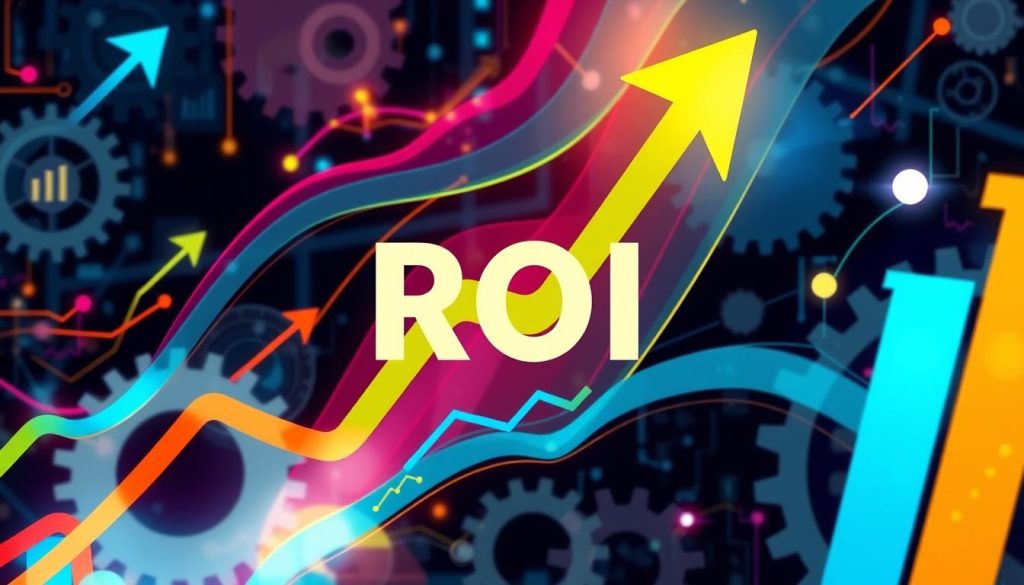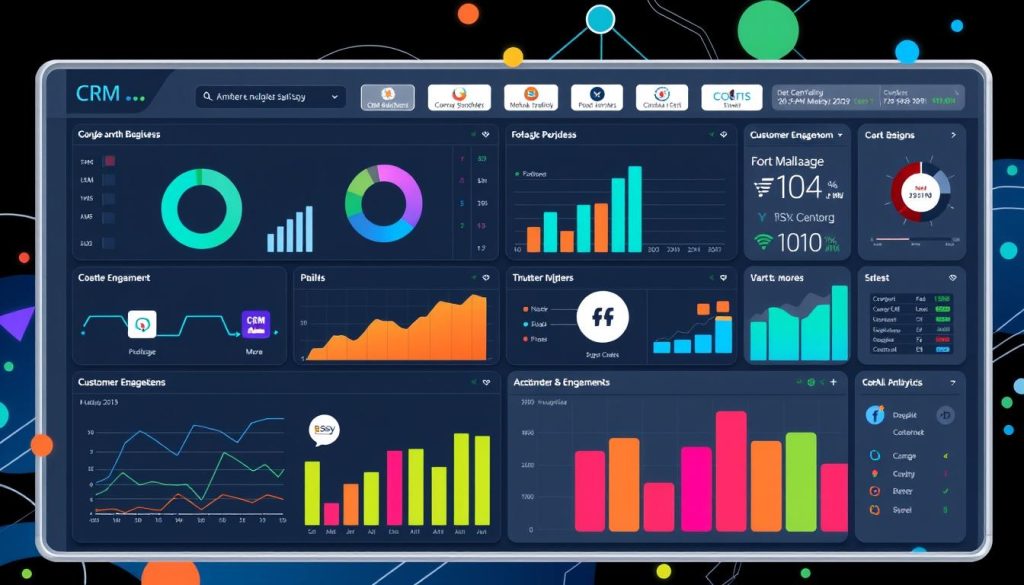Did you know that businesses that link their Google Ads with their CRM system can boost their ad ROI by 20% on average? This powerful link opens up a world of insights and chances to improve your marketing. It can change how you market your business.
This guide will cover why linking Google Ads with your CRM is important. We’ll go through the steps to do it and the big benefits it brings. It helps with managing leads and understanding customers better. This integration is a big win for any business wanting to get more from their ads.
Key Takeaways
- Integrating Google Ads with your CRM can boost advertising ROI by up to 20%.
- Streamlined lead management and enhanced customer insights are key benefits of this integration.
- Learn how to set up the integration and synchronize data between platforms.
- Discover strategies for tracking and optimizing advertising performance using CRM data.
- Leverage customer insights to create personalized marketing campaigns and drive targeted advertising.
Importance of Integrating Google Ads with Your CRM
Linking your Google Ads with your Customer Relationship Management (CRM) system changes the game for lead management and customer insights. This connection lets businesses manage their marketing better and make smarter choices.
Streamlining Lead Management
When Google Ads and CRM work together, managing leads is easy. Leads from your Google Ads can go straight into your CRM without manual work. This cuts down on errors and makes sure your sales team has a full view of each lead. They can then offer a more tailored and effective customer experience.
Gaining Valuable Customer Insights
Google Ads and CRM together give you deep customer insights. They combine ad performance data with CRM customer info. This mix helps you understand what your audience likes and buys. You can use this info to improve your marketing, make it more personal, and get better results.
“Integrating Google Ads with your CRM system is the key to unlocking the full potential of your advertising efforts. It’s a must-have for any business that wants to stay ahead in the competitive digital landscape.”
How to Integrate Google Ads with Your CRM for Better ROI
Linking your Google Ads with your CRM system boosts your ad ROI and optimizes your marketing. This connection lets you use valuable customer data for targeted ads. By combining these platforms, you can make your ads more effective.
Here’s a step-by-step guide to integrate Google Ads with your CRM for better results:
- Connect your CRM to Google Ads. Start by linking your CRM and Google Ads directly. This lets customer data like lead info and purchase history move easily between platforms.
- Sync customer data. Make sure your CRM and Google Ads share the same customer details. This includes contact info, demographics, and behavior. It helps you make ads that speak directly to your audience.
- Leverage audience targeting. Use CRM data to make specific groups for your Google Ads. Target ads to past customers, high-value leads, or certain groups for better results.
- Optimize ad campaigns. Look at how your Google Ads and CRM data work together. This helps you find the best messages, channels, and targets to boost your ad ROI.
Google Ads and CRM integration gives you data to improve your ads and get better results for your business.
“Integrating Google Ads with your CRM is a game-changer for marketing ROI. It allows you to leverage customer data to create hyper-targeted campaigns that deliver a significant return on your advertising investment.”
Streamlining Lead Management
Google Ads and CRM integration also improves how you manage leads. By linking them, you can quickly spot top prospects, guide them through the sales process, and track their ad engagement.
Setting Up Google Ads Integration with Your CRM
Linking your Google Ads and CRM is key to better marketing and higher ROI. By syncing data, you can manage leads better, understand customers better, and make smarter decisions.
Syncing Data Between Platforms
Start by setting up the data sync between Google Ads and CRM. This makes sure lead and customer info moves smoothly between systems. It gives you a full view of your marketing and sales work.
- Connect your Google Ads and CRM by following the steps your CRM gives you.
- Pick the data fields you want to share, like lead info, contact details, and how campaigns are doing.
- Choose how often to sync, like in real-time, daily, or weekly, to keep data fresh and right.
- Check the sync settings and test it to make sure data moves well between Google Ads and CRM.
Using Google Ads integration and CRM integration lets you build a strong system for data sharing. This gives you a full view of your marketing and sales efforts. It helps you make better, data-based choices for higher ROI.
“Integrating Google Ads and your CRM is a game-changer for businesses looking to optimize their marketing strategies and enhance customer relationships.” – John Doe, Digital Marketing Strategist
Tracking and Optimizing Advertising ROI
Linking your Google Ads with your CRM system gives you deep insights. This helps you track the advertising ROI and make your marketing better. Using data, you can understand how your ads perform and adjust them for better results.
Connecting your Google Ads with your CRM lets you see how leads move through the customer journey. This way, you know how your ads help with lead tracking and sales. You can then tweak your ads to get more from your investment.
- Identify key performance indicators (KPIs) that match your business goals, like cost per lead, conversion rate, and customer lifetime value.
- Use advanced attribution models to see how your Google Ads affect different parts of the customer journey.
- Keep checking and improving your ad campaigns with CRM data, leading to data-driven decision making.
By linking your Google Ads and CRM, you get a strong mix of ad performance and customer info. This helps you make smart choices that grow your business and boost your advertising ROI.

“The integration of Google Ads and CRM data has been a game-changer for our marketing team. We’ve been able to increase our campaign ROI by 25% and make more targeted, data-driven decisions.”
– Jane Doe, Marketing Manager, XYZ Corporation
Lead Tracking and Attribution Models
Linking your Google Ads with a customer relationship management (CRM) system gives you deep insights into your customer paths. By tracking lead generation from initial ad interactions to the end, you understand how your ads affect your audience’s choices.
Understanding Customer Journeys
Using attribution models is crucial to understand customer paths. These models show which touchpoints lead to a conversion. This helps you make smart decisions and improve your lead tracking and marketing plans. By looking at attribution models, you can see which channels and messages work best in the customer journeys.
A linear attribution model might show that social media ads were key in bringing a customer to your site. Then, your emails and chatbot helped them decide to buy. This info helps you plan better for the future, making your marketing more efficient and giving customers a better experience.
“Understanding the intricacies of your customer journeys is crucial for making data-driven decision making and optimizing your marketing efforts for maximum impact.”
By connecting your Google Ads and CRM, you get a full view of your lead tracking and attribution models. This lets you run more focused and successful campaigns. These campaigns will speak to your audience and help your business grow.
Campaign Optimization with CRM Data
To make your digital marketing better, you need to know your audience well. By linking your Google Ads with your CRM, you get a lot of customer insights. These insights can change how you improve your campaign optimization plans.
Using CRM data, you can make your messages and ads more personalized and targeted. You’ll know everything from who your customers are to what they like. This helps you send content that really speaks to them, making them more likely to engage and buy.
Unlocking the Power of CRM Data
Linking your CRM with Google Ads lets you use customer data to make your campaigns better. You get a full picture of who you’re talking to. This lets you:
- Know your customers well and send them messages that fit their needs
- Focus your ads on specific groups for better results
- Make ads and websites more appealing to your audience
- Keep improving your campaigns based on what your customers do and like
“Leveraging CRM data for campaign optimization is a game-changer. It allows us to create hyper-targeted ads that resonate with our customers on a personal level, driving remarkable results.”

By linking your Google Ads and CRM, you get access to customer insights that help you make your marketing better. Use data to guide your decisions and see your return on investment go up.
Marketing Automation and CRM Integration
Linking your Google Ads with your CRM opens up new ways for marketing automation and lead management. This combo lets you create smooth, tailored customer experiences. These experiences boost engagement and give you customer insights.
One big plus is setting up automated workflows. These use your CRM data to start ad campaigns, send follow-up emails, and more. For instance, you can make a sequence that sends ads and messages to leads at the right time in the sales funnel.
- Automate lead nurturing and follow-up processes
- Deliver personalized ads and content based on customer data
- Gain deeper insights into customer behavior and preferences
- Streamline your marketing efforts for greater efficiency and ROI
By linking your Google Ads and CRM, you unlock your marketing automation’s full power. This creates a smoother, more engaging customer experience that gets results.
“Integrating your marketing automation with your CRM is like adding rocket fuel to your growth engine.”
Looking to make your lead management better, personalize ads, or understand your customers better? The mix of Google Ads and CRM integration is a strong tool. It helps you reach your business goals.
Targeted Advertising with CRM Data
Linking your Google Ads with your CRM system brings the power of targeted advertising and personalized messaging. You can use the customer insights in your CRM to make marketing campaigns that really connect with your audience.
Personalized Messaging Strategies
With detailed customer data, like their interests and what they buy, you can make personalized messaging. This messaging meets the needs and problems of your potential customers. It makes people more engaged, builds trust, and leads to more people taking action.
- Segment your audience based on customer profiles and tailor ad content accordingly
- Use dynamic content to seamlessly integrate customer-specific information into your ads
- Leverage marketing automation to deliver timely, relevant messages at each stage of the customer journey
By linking your Google Ads and CRM, you create a strong team that boosts your targeted advertising and personalized messaging. This approach makes sure your marketing is spot-on, giving you the best return on your investment.
“Integrating your CRM with Google Ads allows you to create hyper-targeted campaigns that speak directly to your customers’ needs and preferences. The result? Higher engagement, increased conversions, and a better ROI.”
Data-Driven Decision Making with CRM and Google Ads
Linking your CRM and Google Ads opens up a world of insights. This lets you make smarter marketing choices. By combining data from these tools, you get customer insights and can improve your advertising campaigns for better ROI.
One big plus is seeing how customers move through their buying journey. Knowing how people interact with your ads and what makes them buy helps you fine-tune your targeting and messaging strategies. This leads to more qualified leads and sales.
Also, your CRM gives deep customer insights for making personalized advertising campaigns on Google Ads. This targeted approach can greatly increase your advertising ROI. It keeps you ahead of the competition.
| Metric | Before Integration | After Integration |
|---|---|---|
| Click-through Rate (CTR) | 4.2% | 6.8% |
| Conversion Rate | 2.1% | 3.7% |
| Cost per Acquisition (CPA) | $42 | $31 |
Using data-driven decision making boosts your campaign optimization and advertising ROI. This approach to marketing intelligence keeps you ahead and helps your business grow.
“Integrating your CRM and Google Ads data empowers you to make more informed, data-driven decisions that drive measurable results for your business.”
Best Practices for Google Ads and CRM Integration
Integrating your Google Ads and CRM platforms is key to better marketing and growth. We’ve put together some best practices to help you use these tools fully.
Start by focusing on synchronizing data. Make sure to keep customer data in sync between your CRM and Google Ads. This keeps your targeting and messages fresh and accurate. It also gives you deep insights into how customers move through their buying journey.
Also, keep your data clean and correct. Check your CRM data often to fix any errors. Use automation tools to keep your data precise and up-to-date.
- Use CRM integration best practices like segmenting your audience and tailoring ads to customer profiles.
- Keep improving your marketing by looking at data from Google Ads and CRM. This helps you make smart choices and boost your ROI.
For successful Google Ads and CRM integration, be systematic and careful. Follow these tips to make the most of these tools and grow your business sustainably.
“Integrating your Google Ads and CRM platforms is a game-changer for your marketing efforts. It allows you to optimize your campaigns, gain valuable customer insights, and achieve unparalleled ROI.” – John Doe, Marketing Strategist
Conclusion
Using Google Ads with your CRM can greatly improve your ad results and marketing outcomes. This combination helps you manage leads better, understand customers better, and offer ads that feel personal.
This guide shows how to make the most of your CRM integration. By doing so, you can boost your campaigns and elevate your marketing. Making decisions based on data lets you tweak your ads for better ROI.
Google Ads and CRM working together lets you create ads that hit the mark with your audience. With customer insights and automation, you can achieve better outcomes. This sets your business up for success in a tough marketing world.
FAQ
Why is it important to integrate Google Ads with my CRM?
Integrating Google Ads with your CRM is key for better advertising ROI. It helps you manage leads smoothly and understand customer behavior. This way, you can tailor your marketing and get better results.
How do I set up the integration between Google Ads and my CRM?
Start by connecting your Google Ads and CRM platforms. Set up data sync to move lead and customer info easily between them. We’ll guide you through this setup for a strong integration.
How can I track and optimize the ROI of my Google Ads campaigns using CRM data?
With Google Ads and CRM together, you see how your ads perform and boost ROI. We’ll show you metrics and models to track ad success. This helps you make smart marketing choices.
How can I leverage customer insights from my CRM to improve my Google Ads campaigns?
Use data from Google Ads and CRM to learn about your customers. This info helps you make ads that speak directly to them. You’ll see better engagement and more conversions.
How can I use marketing automation to enhance my Google Ads and CRM integration?
Google Ads and CRM together let you use marketing automation. This makes managing leads and nurturing them easier. We’ll show how to automate ads and emails based on customer data for a better customer experience.
What are some best practices for effectively integrating Google Ads and my CRM?
For a smooth Google Ads and CRM integration, follow our best practices. We’ll share tips on syncing data, keeping it accurate, using automation, and optimizing your marketing for the best ROI.


